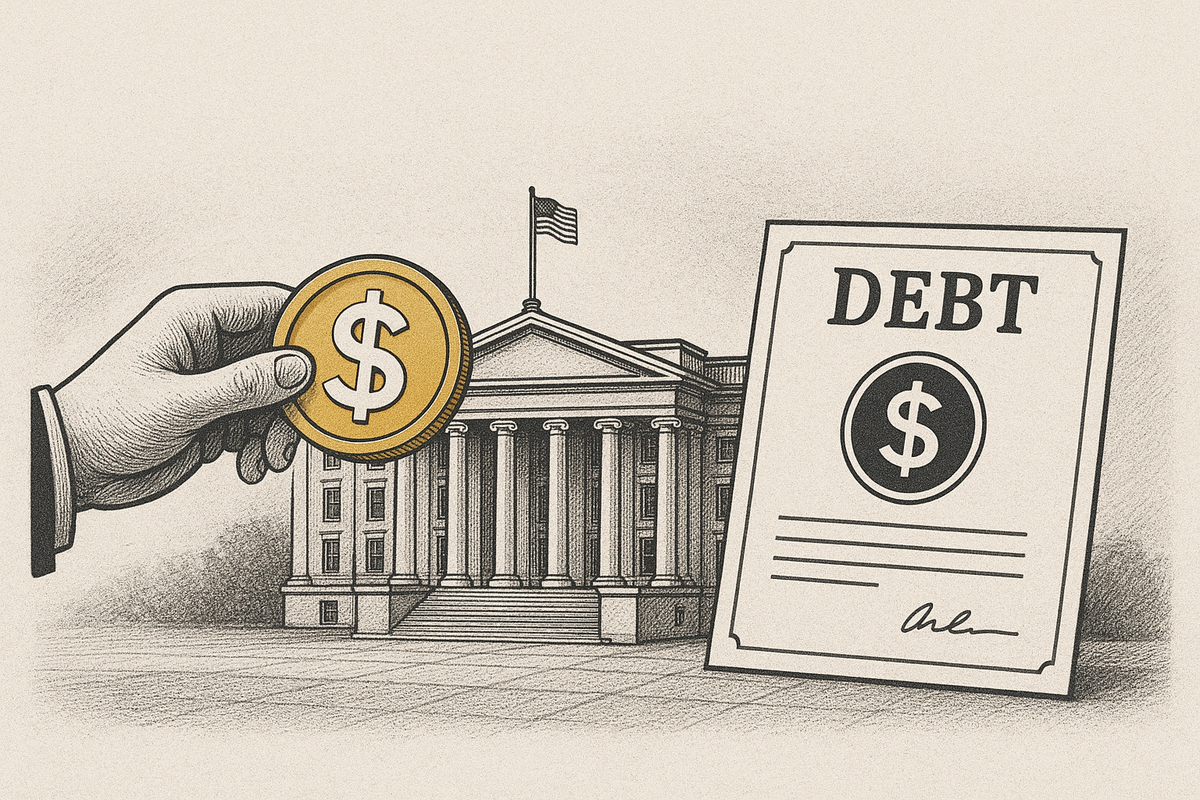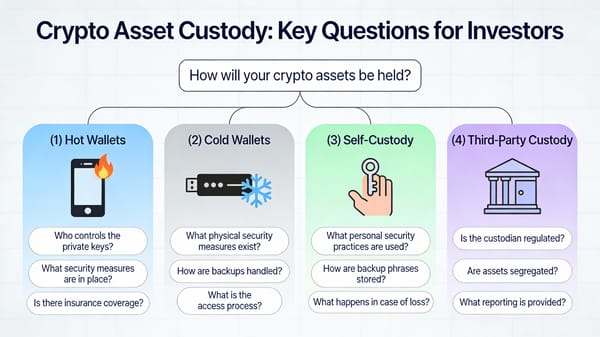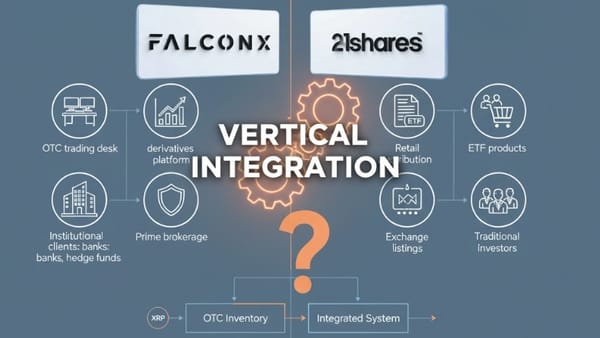Treasury Secretary Bessent's Bold Stablecoin Strategy: Using Digital Dollars to Save America's $37 Trillion Debt Crisis
Treasury Secretary Scott Bessent unveils revolutionary plan to use stablecoins to save America's $37T debt crisis and maintain dollar supremacy. Digital dollars could create $2-3.7T in new Treasury demand by 2030

Scott Bessent unveils revolutionary plan to leverage stablecoins as America's financial lifeline amid mounting debt and global currency challenges.
When Wolf Financial (@WOLF_Financial) posed a provocative question about Treasury Secretary Scott Bessent's stablecoin strategy, it opened the door to a deep exploration of America's most audacious financial gambit. Bessent's declaration that the U.S. will "use stablecoins" to maintain dollar dominance isn't just policy rhetoric—it's a revolutionary approach to solving the nation's $37 trillion debt crisis. What Wolf Financial identified as an overlooked statement has profound implications that could reshape global finance and determine whether America maintains its economic supremacy in an increasingly multipolar world.
The Perfect Storm: Why America Has No Other Options
The timing of Bessent's stablecoin strategy isn't coincidental. The United States faces an unprecedented confluence of economic pressures that threaten its global financial dominance. The national debt rose to $37,004,817,625,842.56 as of August 12th, according to the latest numbers published by the Treasury Department. That is up about $6.3 billion from the figure reported the previous day.
This astronomical debt trajectory is accelerating at an alarming pace. The U.S. hit $34 trillion in January 2024, $35 trillion in July, and $36 trillion in November — meaning each additional trillion has been added roughly every five months. At this rate, financial analysts project the debt could reach $73.5 trillion within a decade if current spending trends continue unchecked.
But the debt crisis is only part of the equation. Foreign nations are increasingly distancing themselves from U.S. Treasury securities, while BRICS+ nations actively explore alternatives to dollar-denominated trade. Countries like Russia, India, China, Brazil and Malaysia, among others, are seeking to set up trade channels using currencies other than the almighty dollar. This de-dollarization movement represents a direct challenge to America's economic hegemony.
The Stablecoin Solution: Digital Dollars for Global Dominance
Bessent's vision transforms what many see as a crypto experiment into a strategic weapon for dollar supremacy. "Stablecoins represent a revolution in digital finance," said Treasury Secretary Scott Bessent. "The dollar now has an internet-native payment rail that is fast, frictionless, and free of middlemen."
The mechanics are elegant in their simplicity. Under new legislation like the GENIUS Act, which President Trump recently signed into law, stablecoin issuers must maintain 1:1 reserves in U.S. Treasuries or cash deposits. This creates a virtuous cycle: as global adoption of dollar-backed stablecoins increases, demand for U.S. government debt automatically rises.
"Stablecoins could end up being one of the largest buyers of U.S. treasuries or T-bills," the Treasury Secretary said in a New York Post interview, explaining how someone using a dollar-backed stablecoin in Nigeria could transact without actually holding physical dollars. This mechanism bypasses traditional banking systems and capital controls that many countries use to limit dollar access.
The scale of this opportunity is massive. Treasury Secretary Scott Bessent praised the bill in a post on X, saying that a regulated and growing stablecoin market could create new buyers for U.S. government debt. Industry projections suggest the stablecoin market could reach $2-3.7 trillion by 2030, potentially making it one of the largest holders of U.S. Treasury securities globally.
Trump Administration's Comprehensive Debt Strategy
Bessent's stablecoin initiative fits into the broader Trump administration's multipronged approach to addressing America's fiscal challenges. Beyond digital dollar innovation, the administration has implemented aggressive tariff policies designed to boost government revenues while reducing trade deficits.
Customs duties rose by $15 billion (286%) compared to last May as increased tariffs on most imported goods continued to bring in higher revenues. These tariff increases, while controversial, represent a significant new revenue stream that complements the stablecoin strategy.
The administration also established a Bitcoin Strategic Reserve, signaling its commitment to embracing digital assets as tools of economic policy rather than threats to traditional finance. Trump has checked the Bitcoin Strategic Reserve off his crypto to-do list, so it looks like stablecoins are next up.
Market Impact and Global Implications
The stablecoin strategy addresses a fundamental paradox in global finance: while foreign governments increasingly reject the dollar, their citizens desperately want access to it. Countries experiencing currency instability, from Argentina to Nigeria, have thriving underground markets for dollar access. Stablecoins provide a digital pathway that circumvents government restrictions while strengthening dollar demand.
Katie Haun, founder and CEO of Haun Ventures and former Coinbase board member, said Friday on "Squawk Box" that the stablecoin industry is already 14th largest holder in the world of U.S. Treasurys, ahead of nations like Germany and Norway. This ranking will likely rise dramatically as regulatory clarity attracts institutional adoption.
The financial mechanics create powerful incentives for growth. As Bessent explained, "A thriving stablecoin ecosystem will drive demand from the private sector for US Treasuries, which back stablecoins. This newfound demand could lower government borrowing costs and help rein in the national debt."
XRP and Ripple: Positioned for the Stablecoin Revolution
The regulatory clarity around stablecoins could significantly benefit established blockchain networks optimized for digital payments. XRP, with its focus on cross-border transactions and institutional adoption, stands to gain substantially from increased stablecoin activity.
XRP Price Potential: As banks and financial institutions integrate stablecoin systems, networks capable of handling high-volume, low-cost international transfers become increasingly valuable. XRP's existing relationships with financial institutions position it well for this transition.
Ripple's Business Operations: Ripple's ongoing efforts to build payment corridors globally align perfectly with the stablecoin infrastructure vision. The company's enterprise focus could accelerate as traditional finance embraces digital dollar rails.
Legal Standing: With the Trump administration actively supporting crypto innovation and regulatory clarity, Ripple's legal challenges may find more favorable resolution, removing a key overhang on the company's growth prospects.
Partnership Opportunities: The government's explicit endorsement of stablecoins creates new partnership possibilities between Ripple and traditional financial institutions looking to integrate digital payment solutions.
Adoption Prospects: As global demand for dollar-based digital transactions increases, Ripple's technology could become essential infrastructure for the new stablecoin economy.
Challenges and Long-term Outlook
Despite its promise, Bessent's strategy faces significant challenges. Lawrence McDonald, founder of the Bear Traps Report, cautioned that additional demand from stablecoins will take time to develop, while the U.S. Treasury will likely need to issue significant amounts of debt securities over the next year.
Critics also worry about the systemic risks of relying heavily on stablecoin demand for government financing. Nonprofit group Better Markets opposes the GENIUS Act, and its policy director Amanda Fischer said in a statement that the bill ignores "the susceptibility of stablecoin companies to runs, bankruptcies, and taxpayer-funded bailouts."
The strategy represents a medium-term solution rather than a permanent fix. While stablecoins may provide crucial breathing room by creating new demand for U.S. debt, they cannot address the fundamental spending imbalances driving America's fiscal crisis. The U.S. might lose its status as the world's reserve currency to alternatives like Bitcoin, the Euro, or the Yuan if debt sustainability issues remain unresolved.
A High-Stakes Gamble with Global Implications
Treasury Secretary Bessent's stablecoin strategy represents one of the most innovative approaches to sovereign debt management in modern history. By transforming cryptocurrency infrastructure into a tool for dollar supremacy, the Trump administration has found a novel way to address America's mounting fiscal challenges while maintaining global financial leadership.
The success of this strategy will depend on rapid adoption of regulatory frameworks, continued global demand for dollar-based digital assets, and the ability to scale stablecoin markets to meaningful proportions. "Thanks to President Trump's visionary leadership, and Senator Hagerty's important work in Congress, the GENIUS Act will help cement the US dollar as the global reserve currency for generations to come."
Whether this digital dollar revolution can truly solve America's $37 trillion debt crisis remains to be seen, but it represents a bold attempt to leverage technological innovation for geopolitical advantage. As Bessent noted, this marks "a seminal moment for digital assets and dollar supremacy"—one that could reshape global finance for decades to come.
Sources
- Axios - "Stablecoins will preserve the U.S. dollar's dominance, Bessent says" (March 2025)
- Cointelegraph - "US will use stablecoins to ensure dollar hegemony — Scott Bessent" (March 2025)
- CNBC - "How the stablecoin bill gives Treasury Secretary Bessent a new tool to fund the U.S. deficit" (June 2025)
- U.S. Department of Treasury - "Statement from U.S. Secretary of the Treasury Scott Bessent on Enactment of the GENIUS Act" (July 2025)
- FOX Business - "National Debt Tracker: American taxpayers are now on the hook for $37 trillion" (August 2025)
- Newsweek - "US Debt Reaches $37 Trillion Years Before Expected" (August 2025)
- Decrypt - "Treasury Secretary Bessent Says Stablecoins Can Bolster US Dollar 'Supremacy'" (June 2025)
- CryptoSlate - "Treasury Secretary Scott Bessent sees stablecoins creating $2T in demand for government debt" (May 2025)
DISCLAIMER: This newsletter is for informational purposes only and does not constitute investment advice or a recommendation to buy, sell, or hold any securities. Investments in cryptocurrencies or other financial assets carry significant risks, including the potential for total loss, extreme volatility, and regulatory uncertainty. Past performance is not indicative of future results. Always consult a qualified financial professional and conduct thorough research before making any investment decisions.



